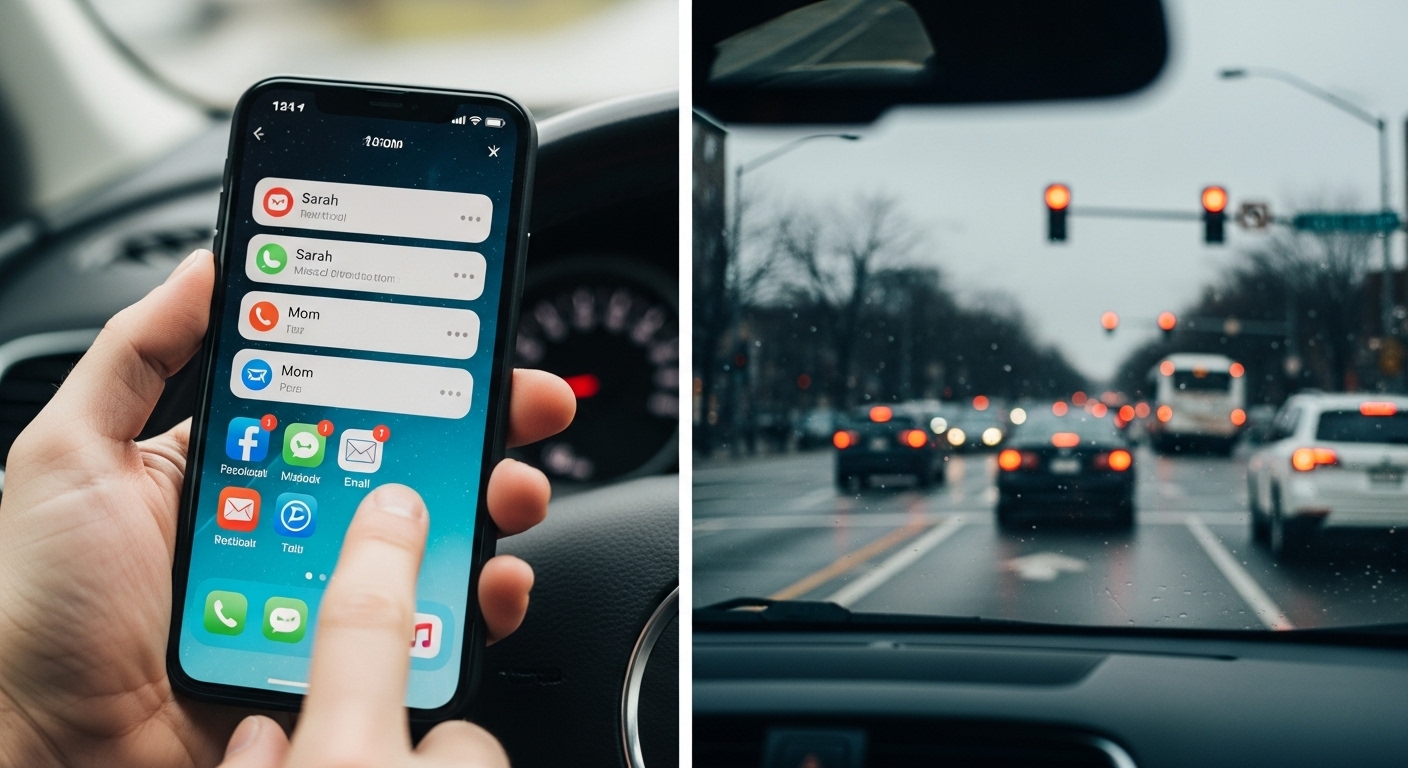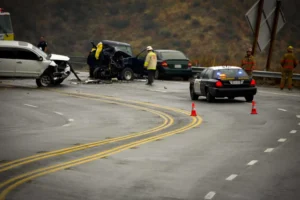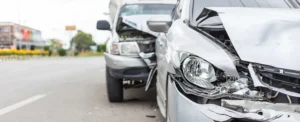You glance down at your phone for just five seconds to check a text message. In that brief moment, traveling at 55 miles per hour, your vehicle covers the entire length of a football field — completely blind to what’s ahead. This split-second decision to divide your attention between the road and your smartphone could be the last one you ever make.
Despite widespread awareness campaigns, stricter laws, and advancing technology designed to curb the problem, distracted driving has paradoxically gotten worse. The numbers tell a disturbing story that every driver needs to understand.
The Alarming Statistics Behind the Crisis
The data from 2025 paints a troubling picture of America’s roads. Distracted driving contributed to approximately 8% of all fatal motor vehicle crashes, claiming over 3,300 lives in 2022 alone. But perhaps most shocking is the trend line — drivers were 30% more distracted in February 2022 than they were in February 2020, making it the worst month for phone distraction in the United States since 2019.
According to the National Highway Traffic Safety Administration, cellphones were involved in 12% of fatal distraction crashes. These aren’t just statistics — they represent real people: parents who never made it home to their children, teenagers who died before experiencing life, and innocent bystanders struck by drivers who thought they could safely multitask.
Who’s Most at Risk?
The demographic breakdown reveals disturbing patterns. Drivers aged 25 to 34 have the highest rate of distraction-related fatal crashes, making up nearly one-fourth of all such incidents. Meanwhile, young drivers between 16 and 24 showed the highest rate of phone manipulation at 7.7%, more than double the national average.
Rhode Island drivers showed the highest phone distraction nationally, averaging over two minutes of active phone use per hour of driving. But no state is immune to this epidemic. Survey data reveals that 60.2% of respondents reported talking on the phone while driving, and a staggering 47% admitted to sending or receiving text messages while behind the wheel.
Why Laws Aren’t Working
By 2025, forty-eight states have enacted texting bans for all drivers, and twenty-five states plus Washington D.C. have implemented complete handheld phone bans. Yet despite this legislative action, the problem continues to intensify. Understanding why requires examining the gap between legal prohibition and human behavior.
The Enforcement Challenge
Laws are only effective when enforced, and distracted driving presents unique enforcement challenges. Unlike speeding, which can be detected by radar, or drunk driving, which produces observable erratic behavior, phone use is often subtle and difficult for law enforcement to observe from a distance. Drivers have become adept at hiding their phone use — holding devices low, using them at stoplights, or quickly putting them away when they spot a police vehicle.
Moreover, even when caught, the penalties often fail to deter repeat offenses. While distracted driving violations can increase insurance premiums by 10% to 30%, many drivers view this as an acceptable risk compared to the perceived necessity of staying connected.
The Technology Paradox
Modern vehicles come equipped with more technology than ever before — touchscreen infotainment systems, smartphone integration, and multiple connectivity options. While these features are marketed as making driving safer and more convenient, they’ve inadvertently created new sources of distraction.
Ironically, the same smartphones causing the problem also offer solutions that most people don’t use. Both iOS and Android devices include Do Not Disturb While Driving features that can automatically silence notifications and calls. Yet research shows that 60% of former users simply forgot to enable these features, while 32% of non-users were completely unaware they existed.
The Psychological Component
Understanding why distracted driving persists despite known dangers requires examining the psychological factors at play. The compulsion to check our phones isn’t simply about poor decision-making — it’s rooted in how our brains respond to digital stimuli.
The FOMO Effect
Fear of Missing Out, commonly known as FOMO, drives many people to check their phones compulsively. Each notification triggers a dopamine response in our brains, creating a reward cycle that’s difficult to break. This neurological reality means that even drivers who understand the risks intellectually struggle to resist the pull of their devices.
Younger drivers, who have grown up in an era of constant connectivity, are particularly vulnerable to this phenomenon. Many believe they can safely text and drive, overestimating their ability to multitask and underestimating the real dangers. This cognitive bias, combined with less driving experience, creates a deadly combination.
The Illusion of Control
Most distracted drivers convince themselves they’re being careful. They might only glance at their phone at red lights, or believe they’re skilled enough to divide their attention safely. However, research consistently shows that all forms of distraction — visual, manual, and cognitive — significantly impair driving performance.
Even hands-free phone conversations aren’t as safe as many people believe. While they eliminate the visual and manual components of distraction, they still create cognitive distraction that reduces a driver’s ability to process their surroundings and react to hazards.
Real Stories, Real Consequences
Behind every statistic is a human tragedy. Sarah Martinez was a 34-year-old mother of two who checked a work email while driving home. In that moment, she didn’t see the car stopped ahead of her. The resulting collision left her with permanent injuries and ended her career. “I thought I was being responsible by keeping up with work,” she recalls. “Now I can’t work at all, and I’ve lost everything.”
Michael Chen survived a crash caused by a distracted driver who ran a red light while texting. The driver, a 19-year-old college student, received only a minor ticket despite Michael suffering injuries that required months of physical therapy. “The legal system doesn’t reflect how serious this problem is,” Michael says. “People treat it like it’s no big deal, but it destroyed my life.”
These stories aren’t exceptional — they’re increasingly common. One in five people killed in distraction-related crashes weren’t even in vehicles; they were pedestrians, cyclists, or bystanders whose lives were cut short by someone else’s momentary lapse in attention.
What Actually Works: Evidence-Based Solutions
While the problem seems intractable, research has identified interventions that can make a real difference. The key is implementing comprehensive approaches that address both the technological and behavioral aspects of distracted driving.
Technological Interventions
Advanced Driver Assistance Systems offer promising solutions. Modern vehicles equipped with lane departure warnings, forward collision alerts, and automatic emergency braking can compensate for momentary driver inattention. These systems don’t prevent distraction, but they provide a crucial safety net when attention lapses occur.
Smartphone-limiting technology shows significant potential. Research from the AAA Foundation for Traffic Safety demonstrates that when properly implemented and consistently used, Do Not Disturb features can reduce distracted driving by up to 41%. The challenge lies in increasing awareness and encouraging habitual use.
Educational and Cultural Shifts
Long-term change requires shifting cultural attitudes about distracted driving. Just as social norms around drunk driving evolved over decades, making it socially unacceptable rather than just illegal, similar changes are needed regarding phone use while driving.
Education must start early, integrating distracted driving awareness into driver’s education programs and continuing through workplace safety training and public awareness campaigns. The message needs to be clear: no text, call, or notification is worth a life.
Protecting Yourself and Others
Individual actions matter. Here’s what you can do to reduce your risk and protect others on the road:
Enable Do Not Disturb features on your smartphone before you start driving. Most modern phones can activate this automatically when connected to your car’s Bluetooth or when motion is detected. Take advantage of this technology — it’s there for a reason.
Place your phone completely out of reach while driving. The glove compartment, a bag in the back seat, or anywhere you can’t grab it without pulling over eliminates the temptation to check it. If you need navigation, set it before departing and use voice guidance.
Set clear boundaries with work, family, and friends. Let them know you won’t respond immediately while driving. Most messages can wait 15 or 30 minutes, and the people who care about you want you to arrive safely more than they need an instant reply.
If you’re a passenger, speak up when you see someone driving distracted. Offer to handle their phone for them, read messages aloud, or simply remind them of the dangers. It might feel awkward, but it could save lives.
For parents, model good behavior and have explicit conversations with teen drivers about the risks. Consider using apps that monitor or restrict phone use while driving, especially during the critical first years of driving experience.
When You’re a Victim
If you’ve been injured by a distracted driver, you have rights. Document everything — take photos of the scene, get witness information, and seek medical attention immediately even if injuries seem minor. Many symptoms of serious injuries don’t appear until hours or days after an accident.
Consult with an attorney who specializes in distracted driving cases. These cases can be complex, particularly when it comes to proving the driver was using their phone at the time of the crash. Phone records, witness testimony, and crash reconstruction analysis may all play crucial roles in building your case.
Remember that you may be entitled to compensation for medical expenses, lost wages, pain and suffering, and other damages. Don’t let insurance companies pressure you into quick settlements before you fully understand the extent of your injuries.
The Path Forward
Distracted driving has gotten worse despite our efforts to stop it, but that doesn’t mean the battle is lost. It means we need smarter, more comprehensive approaches that combine technology, education, enforcement, and cultural change. Every driver makes a choice every time they get behind the wheel — the choice to focus on driving or to divide their attention.
The statistics are sobering, but they also represent opportunities for prevention. Every one of those crashes, injuries, and deaths was avoidable. By understanding the scope of the problem, acknowledging the psychological factors at play, and committing to concrete behavioral changes, we can reverse these troubling trends.
Your phone will always be there when you arrive at your destination. The same cannot be said if you choose to use it while driving. Make the commitment today — put the phone away, focus on the road, and arrive alive.





